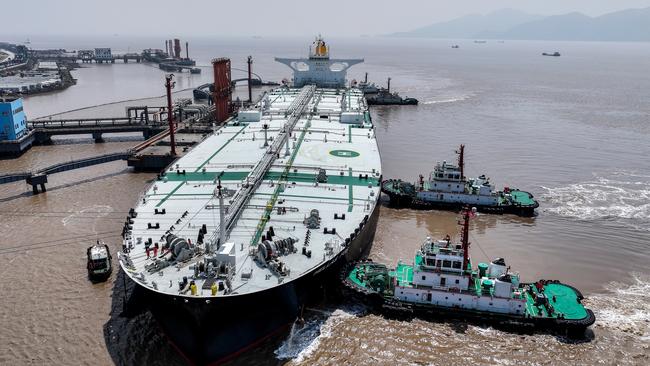High demand and weak supply should keep energy stocks up
Is the rebound in energy stocks real? There are deep fundamentals underpinning the sector’s surge – and they will power it through 2024.

Is the rebound in energy stocks real? It shocks bears, who deem it a short-term head fake fuelled by OPEC+ cuts and Israel-Iran war escalation fears. They say big Aussie energy firms’ profits will wane from lower oil and gas prices. Wrong! Deeper fundamentals underpin the sector’s surge – and they will power it through 2024. Here is why, and how to profit.
Few seers expected energy stocks to sputter in 2023 – not after skyrocketing oil prices during Putin’s Ukraine invasion turbocharged performance in 2022. Instead, most pundits imagined Russian aggression, OPEC+ cutbacks and post-Covid Chinese economic reacceleration stoking a Whitlam-era shortage redux – spiking oil prices anew and powering energy stocks.
My March 2023 column said that, predicting strong production would vanquish shortage fears. It did. In 2023, the sector climbed just 1.9 per cent globally while world stocks soared 23 per cent.
Why? Oil prices had plunged from 2022’s nosebleed high. While production declined Down Under, globally it was super strong, obliterating shortage fears – and output seemed set to keep rising in Norway, Guyana and North America.
US President Joe Biden’s temporary ban on new federal land leases didn’t bite. America, now the world’s biggest producer, eclipsed production records. That kept oil prices range-bound around $US70 to $US95 a barrel, limiting energy profits. Crude prices drive profits and the stocks. US natural gas output hit new records, too. Despite fears Gorgon and Wheatstone strikes would wreck Aussie production, 2023 output decreased less than 2 per cent while gas exports slid less than 1 per cent. Ample supply undercut forecasts of energy outperformance.
Energy bears repeat 2023’s error now – just backwards, extrapolating stock price lag through 2024. They dismiss energy’s rally, claiming OPEC+ cuts plus Ukraine and Middle East wars are merely driving a “temporary” uptick. Fund flows, money manager surveys and valuations all show investors slashing energy holdings. Yet 2024’s oil prices should power up, refuelling energy company profits – pumping oil and gas stocks up a big wall of worry.
Why? Not from ongoing OPEC+ cuts. They are merely symbolic – stocks and oil prices baked them in long ago. Ditto for widely watched regional wars, recent wiggles notwithstanding. And Biden’s pause on new LNG export terminal permits is now facing blowback in Texas, Louisiana and over a dozen other states.
Regardless, Biden’s pause does nothing to stop already permitted and under-construction terminals from amply supplying the world. These in-progress facilities should double North American LNG export capacity later this decade. Besides, efforts to derail further permitting might be moot if November’s election doesn’t go Biden’s way.
Rising prices are about simple incentives. Reacting to 2022’s lofty prices, energy firms boosted production to capitalise. Now? After 2022’s price decline, producers are completing wells far faster than they start drilling new ones. In America – the world’s swing producer – the “fracklog” of drilled-but-uncompleted wells is down 16.1 per cent, year on year. So less inventory can come online quickly.
Producers aren’t replacing it. After years of consolidation as most of last decade’s overextended wildcatters couldn’t keep servicing debt loads amid low prices, the global mega-drillers dominate. With their judicious production targets reigning, the US rig count has fallen 19.1 per cent year on year, negating smaller increases in the Asia-Pacific and elsewhere. US drilled wells are down 15.5 per cent, year on year. Output lags drilled wells by about six months. It will slow soon.
Demand? Pessimistic analysts keep underestimating it, overemphasising weak areas like Germany and China. Yet global growth remains solid. Eurozone GDP returned to growth in the first quarter. America’s was better than headlines suggested. Increased imports – a sign of healthy demand – and inventory drawdowns masked healthy private sector growth. Chinese economic resilience continues to surprise observers. It all signals stronger than expected oil demand ahead.
Hence, oil prices should eclipse 2023’s highs. That, plus cost discipline, should power an energy earnings bonanza. Big integrated oil firms should benefit most. Their stronger balance sheets and low-cost production position them best to capitalise when oil prices rise but don’t skyrocket. As you know, Australia’s exposure is minor, so also shop for them in the US and UK. China has some, too, but that injects an element of regulatory uncertainty you probably don’t need.
But what about the higher fuel prices that higher oil prices bring? They are unpleasant, sure. But Aussie power bills are set to fall from the last two years. And worldwide, economic growth measures and consumer spending have repeatedly shown oil and gas prices aren’t a big swing factor anymore. The global economy and stocks have done fine through stretches of far higher energy price spikes than 2024’s potential.
So get energised about this bull market. It has plenty of fuel left.
Ken Fisher is the founder and executive chairman of Fisher Investments.






To join the conversation, please log in. Don't have an account? Register
Join the conversation, you are commenting as Logout